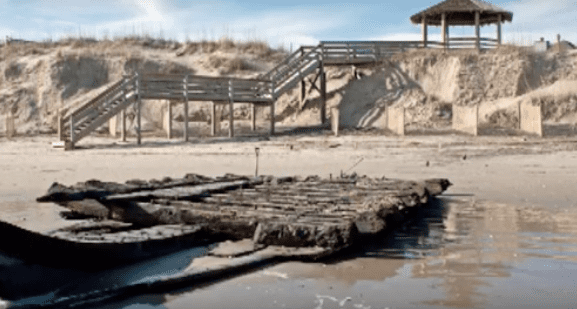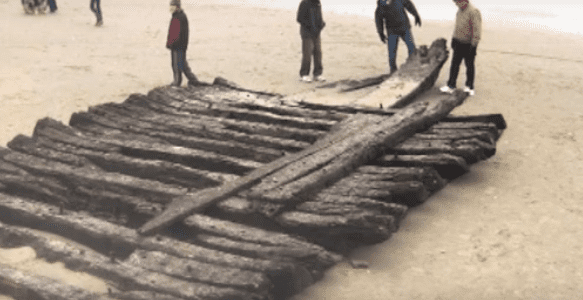All photos and images courtesy of the N.C. Dept. of Natural and Cultural Resources.
The pile of timbers first showed up on the Corolla beach in September of 2008 after a storm passed over the area. They were old…very old, in the shape of the ribs of a ship with the remnants of a keel running down the middle.
In September of 2009, the timbers reappeared and Corolla property owner George Browne noticed there were fewer timbers than before. This time the wreck remained visible on the beach, but the waves and the sand were taking their toll.
In December, Browne called the Underwater Archaeology Branch of the North Carolina Department of Natural and Cultural Resources (UAB) to report what he felt was a significant shipwreck.

According to a 2013 ECU paper by Daniel Brown, UAB indicated Corolla was beyond the daily travel mileage limit they were allowed to travel, and no one could make the trip to the site.
The sea kept rolling in and the wreck migrated up and down the beach, bits and pieces of it lost in the process.
In 2010, UAB was able to get to the wreck, and what they found was a rapidly deteriorating shipwreck that had never been recorded and needed to be preserved. The wreck could not stay on the beach—what they had was clearly historically significant and the constant pounding from the ocean was destroying it. In saving it though, the cure was almost as bad as the disease.

The wreck was massive, a 40’ bow section weighing 12 tons. To get it off the beach, airbags and a forklift raised it high enough for a skid to fit under. Towed off the beach, it was then taken to Corolla Village and eventually loaded on a flatbed for its journey to the Graveyard of the Atlantic Museum in Hatteras where it has been preserved, displayed and studied.
Unfortunately taking it off the beach allowed the wood to dry out, and without the protective covering of salt water, the wood began to deteriorate quickly.
Even in its desiccated state, though, what marine archeologists have found is astonishing.
When Blackbeard’s flagship Queen Anne’s Revenge was located off Beaufort Inlet in 1997, the ship, known to be an early 18th century craft, was thought to be the oldest North Carolina shipwreck.
CKB0022, as the Corolla shipwreck is designated, changed that..
Its name is unknown, even where it was built is uncertain; but one thing is certain CKB0022, is significantly older than Queen Anne’s Revenge.
The evidence for that is overwhelming.
Found in close proximity to (and in one case inside) the wreck were coins dating from 1610-1646. Because the coins were taken from the site before trained archeologists were on hand, they cannot be used to definitively establish a date. However, the circumstantial evidence of where they were found and when would seem to indicate that were part of the ship at one time.
Perhaps most conclusive in dating when the ship was launched are construction techniques that were used.

In an exhaustive study of the wreck undertaken by ECU student Daniel Mark Brown for his master’s thesis, he points to one of the features of the wreck that was perhaps the most easily observed.
“The presences of pre-erected frames assembled with longitudinal treenails and not iron fasteners…” he wrote.
Translation—the ship was held together with the equivalent of wooden pegs. He goes on to note that the Spanish and French were using nails at the time the British and Dutch were constructing their ships with treenails.
There are quite a number of other construction techniques the ship showed that led Brown to conclude, “The author believes that the Corolla Wreck hails from the 17th century, somewhere around the middle of the century or earlier…The dominant presence of treenails, frame-on-keel construction, stringers, and heavy ceiling planking all suggest English or Southern Dutch origins.”
The name of CKB0022 is a mystery. Brown does indicate one intriguing possibility, but he is very careful with what he writes, making it clear that this is only one possibility and quite a number of others may exist.
“The 1652 loss of a former merchant vessel, HMS John, purchased by the English navy in 1646…provide one of the few historical candidates for the identity of the Corolla Wreck. Not enough evidence exists as yet to corroborate the wreck as HMS John, but neither is there enough evidence to say it is not this ship,” he notes.
CKB0022 may remain forever a mystery. As Brown explains, even if the ship was built in England or the Netherlands, there is no way to know if it was sailing at the time of its sinking for either nation.
The remains of the ship are on dry land now, damaged but preserved at the Graveyard of the Atlantic Museum in Hatteras where ongoing work is continuing to try to unravel the mystery. Hatteras is a great day trip from anywhere on the Northern Outer Banks, and the museum makes for a short but fascinating hour or hour and a half visit.
